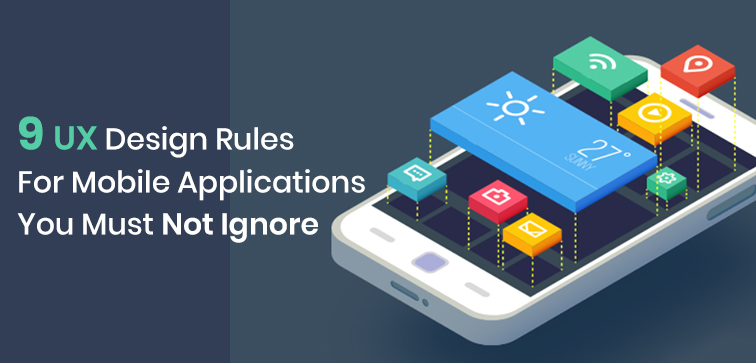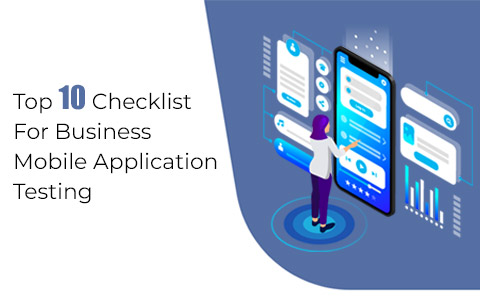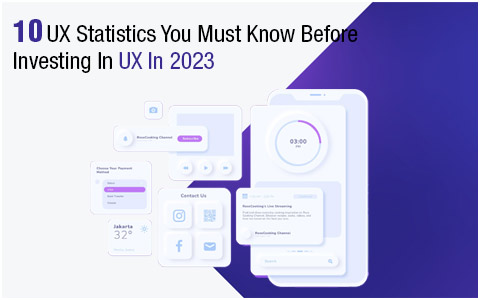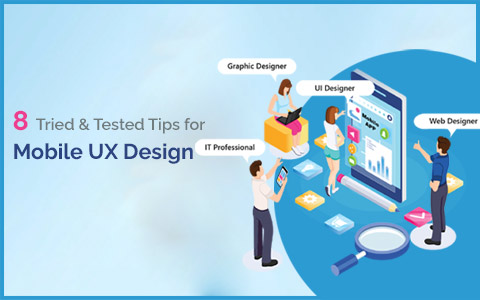9 UX Design Rules For Mobile Applications You Must Not Ignore
 September 22, 2021
September 22, 2021 Mobile Apps Mobile Apps Development
Mobile Apps Mobile Apps Development
“The future of mobile is the future of online. It is how people access online content now.”– David Murphy
We are already living and experiencing the evolution of contemporary technology and there is no denying that it is further going to evolve and change with time. Your consumer who is connected to you/your business through a mobile application will certainly have expectations, and whether you meet those expectations will decide if the user wants to continue using the app.

When we talk about the UX design of the application we often overlook, and sometimes don’t give proper heed to all the information and market requirements that are already available. You can leverage this information to refurbish and enhance your business application to boost your business presence.
In this blog, we are going to reveal the nine most business-critical mobile app design rules that one must follow to make sure the UX design of the application is meeting every criteria and expectation set by your target audience.
For the Latest Mobile Web Design & Development Services from India, you can directly reach out to Midas. Check out the service section for more information.
9 Rules To Achieve Excellent Design & Deliver Outstanding User Experience
1. UX & UI Are Interdependent Yet Different:
UI is User Interface that focuses mainly on the interaction between the software/app and user; on the other hand, UX is User Experience that encompasses the user’s overall experience with the application or brand. When developing your business mobile app, make sure to enhance UX as well as UI.
2. Your Target Audience Is Priority:
What your mobile application should look like and how your user/potential buyer can relate to the services you are presenting through your application will depend on how well you have researched about your target audience.
To survive the market competition, you must design your mobile app focusing on the target user of the business. A user-friendly application with a seamless design that performs smoothly on different mobile devices should be one of the key goals.
3. UX Design & Short Attention Span:
The modern user has perfected the skill of surfing online but the downside of this change is their short attention span.
This is the age when an online user runs short on patience and that is another significant user behavior that app designers must consider when developing a mobile application.
Your focus should be delivering information quickly while simplifying the interface simultaneously. Get rid of elements from your design that can act as hurdles for your user when navigating the application.
Also, do not bewilder your user with more than the required content/information. Keep everything clean and precise.
4. UX Design And UX Development Process:
UX development process is highly important when planning an engaging & interesting user experience for your users. However, it is a general assumption that there is a single set process that must be followed.
On the contrary, every project requirement differs and your UX development process should proceed to meet those requirements. For instance, the process for UX design development for a new iPhone application will differ from an existing mobile application that just needs refurbishment/redesign.
In the former case, you will have to invest more time in researching about the type of audience you are targeting while in the latter case you just need validation and approval on the type of design you will use (which can be done using A/B testing and usability testing).
5. UX Design & Mistake Of Skipping Prototype:
It is common to confuse your preference with mass preference, meaning you cannot just think that a design will work (for your audience) just because you are in awe of the design.
Rather than finalizing the design in the initial stage and proceeding with the completion, it is better to first release the prototype of the design and once this MVP version clears all the tests then you can start the final development.
6. UX Design & Original Content:
Content is an integral part of your application design. It can be in text format, video, or image format. It is important to not miss this critical aspect of your design and UX development. You can win your user or pique their interest by including original, user-relevant content in your mobile app design.
7. UX Design & Simplicity Factor:
Complicated relations don’t last, what makes you think a complicated design will?!
Influencing your target user is quite a challenge already but if you do not start with seamless navigation (for your mobile app) then it can become one major roadblock to success.
UX designers should focus on keeping the design consistent, clear, simple, and easy to understand.
8. UX & Usability Factor:
As a professional UX designer, you must know that the functionality and accessibility of your mobile app should be the primary concern whereas aesthetics and appeal come second on the priority list.
For your mobile app to be successful among users it is essential to assess the usability factor of your product. Is it easy for your target user to understand, learn and navigate your mobile app?
Is your application designed to adapt to your diverse user requirements? For instance, is differently abled user (low vision, motor impairment or hearing impairment, etc.) able to access the application with the least complexity?
9. Progress In Not A Linear Process & So Is UX Design Development:
You will have different UX development stages (such as ideation, prototyping, and testing).
The right way to perform the UX design process is to go back and forth between these stages to ensure you achieve the best result.
You should also prioritize the application security factors. You will refine and iterate your design when you will get more feedback from your users and accordingly refurbish the design.
Conclusion:
Your mobile application must be able to provide seamless engagement to your users. Behind every distinguished design lies excellent planning and design strategy. Midas is a leading mobile web development and design company from India. We develop and design interactive, interesting, and user-relevant mobile apps and websites. Call Us To Know More About Our Top Solutions!
popular post
-
7 Ways Your Ecommerce Website Fails To Succeed

-
Best 5 Reasons That Make It Obvious That You Need Mobile App For Business

-
10 Checklist For Your Business Mobile App Testing

Categories
- Internet Marketing (13)
- Software Development (8)
- Mobile Apps Development (44)
- Web Designing (32)
- Web Development (60)
 business@midaswebtech.com
business@midaswebtech.com




